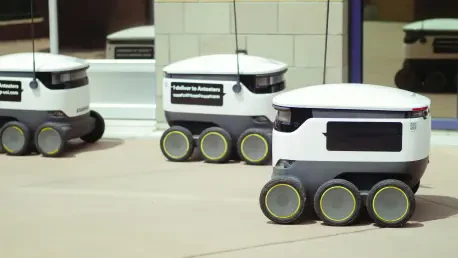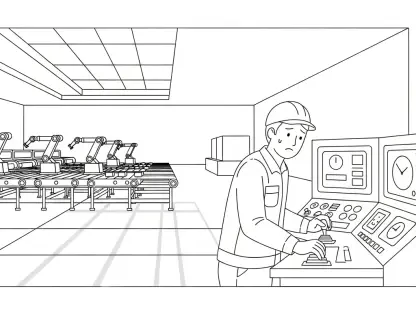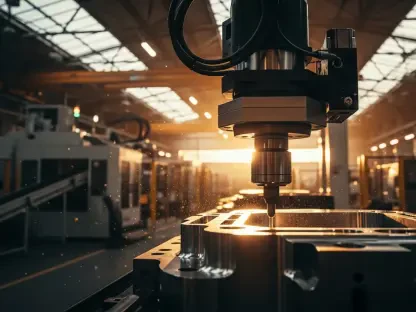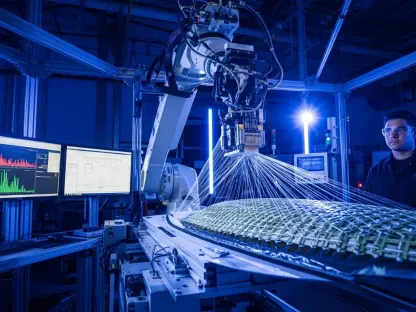In the heart of modern industrial hubs, artificial intelligence (AI) is reshaping manufacturing with a speed and precision that rivals the most transformative eras of industrial history, driving efficiency to unprecedented levels. This technological wave is not merely an upgrade but a fundamental shift, addressing critical challenges such as supply chain volatility and pressing sustainability goals in a highly competitive global market. AI’s integration into manufacturing processes promises to streamline operations and redefine productivity standards. This analysis delves into the AI Productivity Cycle, explores real-world applications, incorporates expert insights, evaluates future implications, and distills key takeaways for industry stakeholders navigating this dynamic landscape.
Understanding the AI Productivity Cycle in Manufacturing
Growth and Adoption of AI-Driven Frameworks
The adoption of AI in manufacturing has surged dramatically, with industry reports indicating a sharp rise in connected digital infrastructures over recent years. Studies suggest that by 2025, over 60% of leading manufacturers will have integrated AI tools into their operations, a trend expected to grow through 2027. This widespread implementation is fueled by the promise of enhanced operational efficiency, with AI-driven systems cutting production downtime by significant margins.
Beyond efficiency, manufacturers leveraging AI and digital threads—systems that connect data across a product’s lifecycle—report substantial cost reductions, often by as much as 20% in key areas like inventory management. Additionally, product innovation cycles have accelerated, enabling companies to bring new offerings to market faster than traditional methods allow. These metrics underscore a clear trajectory toward AI becoming a cornerstone of industrial strategy.
This growth is not without its catalysts, as global pressures like supply chain disruptions push firms to adopt smarter, predictive technologies. The convergence of AI with mature digital ecosystems is creating a robust foundation for manufacturers to respond to market shifts with agility. As adoption rates climb, the focus shifts to how these frameworks translate into tangible outcomes across diverse operations.
Real-World Applications of the AI Productivity Cycle
The AI Productivity Cycle operates through three distinct phases—Discover, Enrich, and Amplify—each playing a critical role in transforming manufacturing processes. In the Discover phase, AI tools like machine learning analyze vast datasets from product lifecycle management systems to uncover hidden insights, such as identifying root causes of defects in production lines. This rapid detection capability allows companies to address issues before they escalate, saving time and resources.
Moving to the Enrich phase, the focus shifts to expanding connectivity across systems and stakeholders through a digital thread. For example, a major automotive manufacturer recently integrated AI to link design specifications with real-time factory data, eliminating silos and ensuring seamless updates on regulatory compliance and carbon footprint metrics. Such connectivity fosters resilience, enabling firms to adapt to external changes while maintaining a commitment to sustainability.
In the Amplify phase, advanced AI applications like generative design come into play, as seen in an aerospace company that used scenario planning to model supply chain disruptions and optimize product designs for cost and performance. This stage slashes design cycles and encourages bold experimentation with minimal risk, transforming traditional processes into reusable, efficient models. These case studies illustrate how the cycle builds momentum, driving innovation at every step.
Expert Perspectives on AI’s Role in Manufacturing
Industry leaders emphasize the transformative power of the AI Productivity Cycle, particularly when paired with a connected digital thread. Rob McAveney, CTO at Aras, highlights that this framework enables manufacturers to tackle complex “what if” scenarios with speed, fundamentally altering decision-making processes. His insights point to a future where AI is not just a tool but a strategic enabler of industrial evolution.
However, experts also caution against underestimating the challenges of scaling AI technologies across enterprises. Many organizations still grapple with fragmented systems, requiring a cultural and structural shift from isolated experiments to cohesive, enterprise-wide strategies. This transition demands investment in infrastructure and a readiness to embrace change at all levels of operation, a hurdle that remains significant for smaller players.
Despite these obstacles, there is a strong consensus on AI’s inevitability in manufacturing, aligning with broader objectives like building resilience against market fluctuations and meeting environmental responsibilities. Thought leaders argue that integrating AI is no longer optional but essential for staying competitive. Their perspectives collectively paint a picture of an industry at a pivotal moment, poised to redefine its future through intelligent systems.
Future Implications of AI Productivity in Manufacturing
Looking ahead, the AI Productivity Cycle is expected to evolve with advancements in generative design, predictive modeling, and personalized manufacturing processes. These innovations could enable manufacturers to tailor products to individual customer needs at scale, a capability that promises to reshape market dynamics. Such developments are likely to further reduce time-to-market, offering a distinct edge in fast-paced industries.
While the benefits are compelling, challenges loom on the horizon, including concerns over data security as digital threads expand to encompass more sensitive information. Additionally, the need for workforce upskilling becomes critical, as employees must adapt to increasingly sophisticated tools. Balancing technological reliance with human oversight will be essential to mitigate risks of over-dependence on automated systems.
The broader impact of AI-driven manufacturing extends beyond factory walls, potentially stabilizing supply chains through predictive insights and enhancing customer experiences with customized offerings. However, global competitiveness could intensify as early adopters gain significant advantages, leaving latecomers at risk of falling behind. These implications highlight the dual nature of AI as both an opportunity and a complex challenge for the industrial sector.
Embracing AI for a Smarter Manufacturing Future
Reflecting on the journey, the exploration of the AI Productivity Cycle reveals a structured pathway that has empowered manufacturers to enhance productivity, as evidenced by real-world applications and expert validations. The integration of AI with connected digital threads has proven instrumental in tackling intricate industrial challenges, setting a new benchmark for operational excellence during this transformative period.
Looking back, the insights gathered underscore a pressing need for proactive adoption of AI strategies to sustain momentum. Manufacturers are encouraged to prioritize investments in robust digital infrastructures as a foundation for long-term growth. By focusing on scalable solutions and workforce development, stakeholders can position themselves to navigate future complexities with confidence, ensuring that innovation and sustainability remain at the core of industrial progress.









